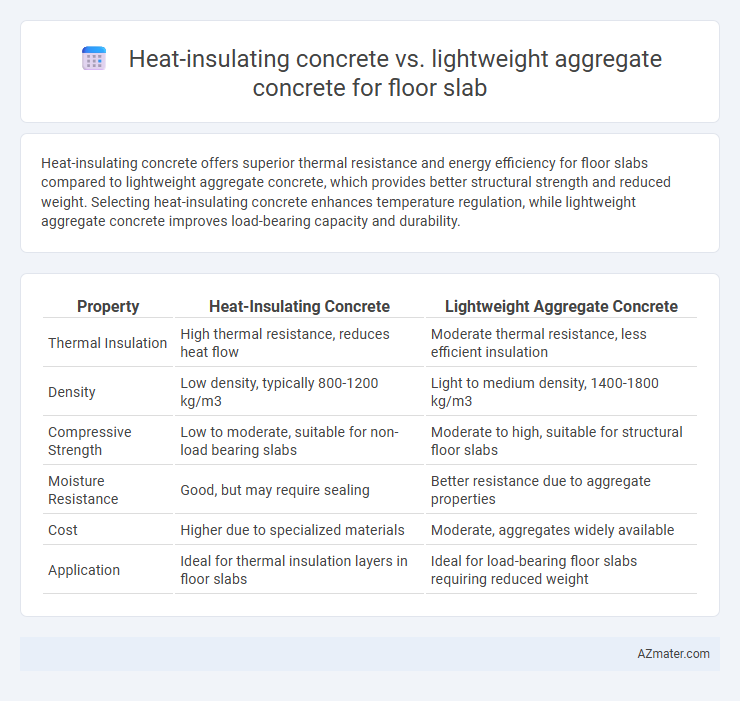Heat-insulating concrete offers superior thermal resistance and energy efficiency for floor slabs compared to lightweight aggregate concrete, which provides better structural strength and reduced weight. Selecting heat-insulating concrete enhances temperature regulation, while lightweight aggregate concrete improves load-bearing capacity and durability.
Table of Comparison
| Property | Heat-Insulating Concrete | Lightweight Aggregate Concrete |
|---|---|---|
| Thermal Insulation | High thermal resistance, reduces heat flow | Moderate thermal resistance, less efficient insulation |
| Density | Low density, typically 800-1200 kg/m3 | Light to medium density, 1400-1800 kg/m3 |
| Compressive Strength | Low to moderate, suitable for non-load bearing slabs | Moderate to high, suitable for structural floor slabs |
| Moisture Resistance | Good, but may require sealing | Better resistance due to aggregate properties |
| Cost | Higher due to specialized materials | Moderate, aggregates widely available |
| Application | Ideal for thermal insulation layers in floor slabs | Ideal for load-bearing floor slabs requiring reduced weight |
Introduction to Heat-Insulating Concrete and Lightweight Aggregate Concrete
Heat-insulating concrete incorporates lightweight materials such as expanded polystyrene or aerogel to enhance thermal resistance in floor slabs, effectively reducing heat transfer and improving energy efficiency. Lightweight aggregate concrete uses natural or artificial lightweight aggregates like expanded clay, shale, or slag, offering reduced density and improved insulation without compromising structural integrity. Both types optimize floor slab performance, with heat-insulating concrete prioritizing thermal insulation and lightweight aggregate concrete balancing strength and insulation.
Key Properties of Heat-Insulating Concrete
Heat-insulating concrete for floor slabs exhibits low thermal conductivity values, typically ranging from 0.1 to 0.3 W/m*K, which significantly reduces heat transfer compared to lightweight aggregate concrete with conductivity around 0.3 to 0.6 W/m*K. This type of concrete also provides superior fire resistance, often enduring temperatures above 1000degC without compromising structural integrity. Its density is generally lower, around 800 to 1500 kg/m3, enhancing thermal insulation while maintaining adequate compressive strength for floor slab applications.
Key Properties of Lightweight Aggregate Concrete
Lightweight aggregate concrete for floor slabs offers enhanced thermal insulation due to its porous aggregates, reducing heat transfer compared to traditional concrete. Key properties include lower density, improved fire resistance, and high strength-to-weight ratio, which contribute to structural efficiency and energy savings. This concrete type also exhibits better sound insulation and reduced dead load, optimizing building performance and occupant comfort.
Thermal Performance Comparison
Heat-insulating concrete provides superior thermal resistance with lower thermal conductivity values, typically around 0.09 to 0.15 W/m*K, compared to lightweight aggregate concrete, which ranges from 0.15 to 0.25 W/m*K. This enhanced insulation reduces heat transfer through floor slabs, improving energy efficiency and indoor comfort. Lightweight aggregate concrete, while offering moderate thermal performance, also contributes to structural strength and reduced slab weight but may require additional insulation to achieve comparable thermal resistance.
Mechanical Strength and Load-Bearing Capabilities
Heat-insulating concrete typically exhibits lower mechanical strength and load-bearing capabilities compared to lightweight aggregate concrete, which benefits from enhanced structural performance due to its denser aggregate composition. Lightweight aggregate concrete provides superior compressive strength and improved durability, making it more suitable for high-load floor slab applications. Thermal insulation in heat-insulating concrete often compromises its ability to withstand heavy structural loads, whereas lightweight aggregate concrete achieves a balance between insulation properties and mechanical resilience.
Installation and Workability Differences
Heat-insulating concrete offers superior thermal resistance with a composition often including insulating aggregates, yet it demands more careful handling due to its lower workability and longer setting times compared to lightweight aggregate concrete. Lightweight aggregate concrete provides better workability and easier installation on floor slabs thanks to its uniform aggregate size and enhanced flow properties, allowing for quicker placement and finishing. Contractors favor lightweight aggregate concrete for projects prioritizing speed and ease of installation, while heat-insulating concrete is selected where enhanced thermal performance is essential despite increased labor effort.
Cost and Material Availability
Heat-insulating concrete offers superior thermal resistance due to the incorporation of insulating materials like expanded polystyrene or perlite, making it more expensive and sometimes limited in availability depending on regional suppliers. Lightweight aggregate concrete utilizes natural or synthetic lightweight aggregates such as expanded clay or shale, which are generally more cost-effective and widely accessible, reducing overall project expenses. Material availability significantly impacts logistics and lead times, with lightweight aggregates typically sourced locally, whereas specialized insulating additives may require longer procurement periods and higher upfront investment.
Environmental Impact and Sustainability
Heat-insulating concrete reduces energy consumption in buildings by enhancing thermal resistance, leading to lower heating and cooling demands and decreased carbon emissions over the lifecycle of the structure. Lightweight aggregate concrete utilizes recycled industrial by-products such as expanded shale or slag, minimizing landfill waste and reducing the embodied energy associated with traditional aggregates. Both materials contribute to sustainable construction practices, but heat-insulating concrete offers greater benefits in operational energy savings, while lightweight aggregate concrete excels in reducing the environmental impact of raw material extraction.
Best Applications for Each Concrete Type in Floor Slabs
Heat-insulating concrete excels in floor slabs requiring superior thermal resistance, such as in cold climates or energy-efficient buildings, reducing heat loss and enhancing indoor comfort. Lightweight aggregate concrete is ideal for floor slabs demanding reduced structural load and improved fire resistance, often used in multi-story construction and seismic zones. Both types optimize specific performance criteria, with heat-insulating concrete prioritizing thermal insulation and lightweight aggregate concrete enhancing structural efficiency.
Summary: Choosing the Right Concrete for Your Floor Slab
Heat-insulating concrete offers superior thermal resistance, making it ideal for energy-efficient floor slabs in colder climates, while lightweight aggregate concrete provides enhanced structural strength and reduced weight suitable for multi-story buildings. The choice depends on balancing insulation needs with load-bearing requirements and project budget. Evaluating thermal conductivity, compressive strength, and long-term durability ensures optimal performance of the floor slab.

Infographic: Heat-insulating concrete vs Lightweight aggregate concrete for Floor slab
 azmater.com
azmater.com